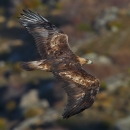In the Eagle Conservation Plan Guidance for incidental take of eagles associated with wind energy, the U.S. Fish and Wildlife Service developed a collision risk model to predict the number of golden and bald eagles that may be killed at wind facilities. The Collision Risk Model incorporates existing knowledge of eagle use around a proposed wind facility (exposure) and the probability of an eagle colliding with an operating turbine. This information is meant to reflect how exposure and collision probability can vary across the nation and takes the form of prior probability distributions. These distributions of prior knowledge are combined with project-specific information to predict the number of fatalities expected for a particular wind facility. The Service intends that these priors be updated as new information becomes available.
Publication date
Program
Species
FWS Focus
FWS Focus


